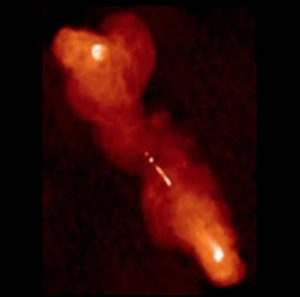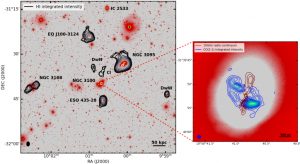
A. Radio image of the jetted AGN 3C219 produced using observations from the Very Large Array at 1.4 GHz
Massive galaxies host, in their nuclear regions, a black hole whose mass is billions of times larger than the Sun. Due to their intense gravitational field, these black holes attract all the surrounding material. During this process, an enormous amount of energy is released across the entire electromagnetic spectrum. These galaxies are referred to as ‘Active Galactic Nuclei’ (AGN). Radio frequencies are particularly important to study the subclass of AGN that develops jets of relativistic plasma. IRA has a well-established expertise in the study of the physics of these sources, using both national and international cutting-edge radio telescopes.
Staff: R. Baldi, M. Bondi, M. Brienza, G. Brunetti, V. Casasola, F. D’Ammando, M. Giroletti, R. Lico, E. Liuzzo, K.H. Mack, N. Marchili, M, Massardi, G. Migliori, M. Orienti, I. Prandoni, C. Stanghellini, T. Venturi, C. Spingola
Collaborators: D. Dallacasa, G. Giovannini, C. Nanci, P. G. Rupal
AGN jet physics
Many aspects of the jet physics are still in debate, such as the launching mechanism, jet collimation, high-energy emission and particle acceleration. High angular resolution VLBI observations are the only means to image the jet base and determine the jet structure and its physical properties. The Event Horizon Telescope has already proved new imaging capabilities on horizon scales. IRA is involved in space VLBI, (mm-)VLBI and multi-wavelength observations up to gamma rays, that strongly suggest the emergence of superluminal jet components during particular phases of jet activity, and the existence of a transverse velocity gradient of the plasma in the jet. Both the superluminal components and the stratified jet have important implications on the origin of the gamma-ray emission from AGN, which is observed by Fermi-LAT and Cherenkov telescopes – such as MAGIC and CTA. The detection of high-energy neutrinos from the radio source TXS 0506+056 provided the first compelling evidence of hadronic processes in AGN jets, giving the unprecedented opportunity to combine more than one messenger to solve for long-standing puzzles in the jet physics. IRA is also involved in multi-frequency studies of the hot spots in powerful jetted AGN. These are the jet termination regions and are usually bright, highly polarized and compact. Here particles are reaccelerated by shocks and turbulence and may emit synchrotron radiation up to the optical and even the X-ray band, as suggested by deep VLT, HST and Chandra observations.
Feeding and feedback in jetted AGN

B. Multi-wavelength view of the group of NGC 3100 and of its circum-nuclear regions. Left panel: Primary beam-corrected H I contours overlaid on a r-band image from VEGAS of the NGC 3100 group. Right panel: VEGAS r-band map zoomed onto the inner 15″ × 15″ (≈2.5 × 2.5 kpc2). The colour scale is inverted compared to the left panel. ALMA CO(2–1) integrated intensity contours and radio continuum contours from JVLA data at 10 GHz are overlaid in blue and red contours, respectively
AGN feedback processes are claimed to have an important impact on the evolution of galaxies. AGN feedback – in the form of radiation, jets and pressure-driven winds – may indeed heat and remove gas from the nuclear regions of galaxies, suppressing star formation and regulating their growth. Such mechanisms are necessarily closely related to the feeding process of the central SMBH and its duty cycle. However, the way in which feeding/feedback loops can be established and sustained over many orders of magnitude in scale is not understood, yet. Open questions are for instance how the gas gets from Kpc scales to the vicinity of the SMBH, and the origin of the gas feeding the SMBHs. Galaxy mergers and interactions, as well as chaotic accretion, are all considered viable ways to bring cold gas to the center of galaxies. Less clear, however, is the relative importance of the aforementioned processes in different classes of galaxies or environments. IRA is involved in detailed studies of local samples of both radio- and optically-selected AGN, with the aim of better understanding the AGN fueling/feedback cycle, through spatially-resolved observations of the various gas phases (ionised and molecular) and of the stellar and dust components in the host galaxies. An important role in these studies is played by ALMA, which allows us to directly probe the dynamics of the molecular gas down to 10-100 pc scales, looking for signatures of inflow/outflow motions, as well as deep HI observations enabled by SKA precursors, which allow us to trace the accretion of cold gas on circum-galactic scales.
Evolution of jetted AGN
The evolution of AGN jets takes place through several phases. At the beginning they are intrinsically compact, with linear sizes between a few pc to a few kpc, and pierce their way through the interstellar medium of the host galaxy which may slow down or even frustrate their expansion. Some jets manage to grow beyond the stellar body of the host galaxy and expand into the intergalactic medium, reaching sizes up to a few Mpc. After a period that lasts between a few tens and some hundreds of Myr, the nuclear activity ceases and the jet supply stops. During this “remnant” phase, the radio lobes inflated by the jets expand and radiate away their energy, becoming quickly invisible. Interestingly, jets can be triggered multiple times during the host galaxy’s lifetime, so that this cycle of evolution is repeated. IRA has a longstanding experience in the study of various evolutionary phases of the jetted AGN, which are key to quantify the energetic impact that the AGN jets have on their host galaxy. For example, by using (sub-)arcsecond radio observations with EVN, JVLA and VLBA telescopes, the physical properties of young jets in AGN are investigated, as well as the role that the interstellar medium has on their evolution. A considerable effort is also put in the characterisation of the spectral and morphological properties of large-scale jets by combining MHz and GHz frequency instruments like GMRT, LOFAR, MeerKAT, EVN and JVLA, with the aim of investigating the timescales of their activity and their interaction with the intergalactic medium.
Credits
Figure A: NRAO/AUI
Figure B: NGC 3100 Maccagni et al. 2023, A&A, 675A, 59. “The AGN fuelling/feedback cycle in nearby radio galaxies. V. The cold atomic gas of NGC 3100 and its group”, Figure 1. DOI: 10.1051/0004-6361/202346521
